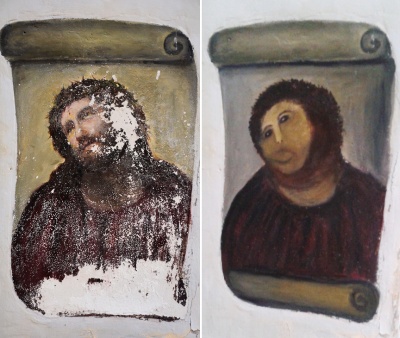There is something of cosmic proportion in this story. In the now famous village of Borja, a fresco from a minor artist, Elías García Martínez was defaced by a local resident, Cecilia Giménez, an Octogenarian who, in good faith, decided to benevolently restore the painting to preserve it from humidity.
An amateur painter, her skills were not up to the job and she, unwillingly, massacred the original with a completely unrelated grotesque rendition. In doing so, she created a completely new piece of art:

The Ecce Homo of Elías García Martínez (left) restored by Cecilia Giménez (right).
The artistic expression there does not come from the technical or even visual quality of the final result, but on the circumstances: the generous, bold and determined attempt to restore a (locally) cherished treasure, and the ludicrous result.
I love the way she interpreted the original, how it changed in such deep ways, even on basic things like, the direction of the look. If you wonder about the unfinished part around the mouth, it's because she had to interrupt the restoration for a trip. Later, in her defence she indeed argued that she hadn't even finished. When learning about that, the movie producer Alex de la Iglesia, a supporter of this version, exlaimed:[1]
- Que se lo dejen terminar, por el amor de Dios!!!! (!?)
The poor woman was badly affected by the attention this incident generated[2]. I hope she will get over it. It seems that most people, including the family of the artist (!?), are understanding and forgiving. Although she didn't do it on purpose, and in fact precisely for that, we should be thankful for her unique input.
It's not merely funny (it is funny too). I see it, as I said in the opening of this post, as an event of universal proportion. We have everything in there: how destruction can become artistically constructive (!?), how a nobody can impact so strongly with a paintbrush, how a talentless stroke can bring an obscure masterpiece to fame, our own perception of Art and of that from others, what defines it, how we interact with it, if we are entitled to anything but witness the passing of time, how much restoration alters the original, etc., to even more fundamental issues, such as blundering horribly and irremediably.
The original artist is not cheated either. Without the beautiful image buried below this ineffable version, the new layer has no value. It is a synergistic piece of art where the original becomes valuable by the sacrifice of its loss to become a pedestal to its unsettling substitute. It is like when Maude shockingly throws a beloved gift from Harold in the sea [3] with the revelation that "now we will always know where it is."
Imagine entering the church of Borja—a must-go destination now (!?)—unknowingly of this incredible story. What would be your reaction in seeing this fresco? Would you think it's a precious middle-age precursor to the black paintings, or an abstract post-modernist representation of a monk? Would you even notice it? If you were told this is Christ, what would you think? It is so utterly defiant of all the artistic conventions, it is clearly something special. The Hinton St Mary Mosaic doesn't look any more dignified and Christ-like than that. Give Cecilia's painting the benefit of the doubt and, in its present location, it will be moved by unknowing future generations to the British museum. Even if skilled enough to recognize the modern hand of a sheer amateur, you'd have to recognize this is, given the context, an instant top-example of these things which are so bad, they are actually good.
There is a petition for the current version to be preserved (rather than attempting a restoration which, for a work of this level, can be simply painted anew by a gifted artist or, even worse, the display of a photography of the original). You can sign it here. I did. The testimonials are as diverse as touching. Isn't it the mark of a great work to elicit such a variety of strong feelings?
At the same time that this story makes a lot of noise a bit everywhere (newspapers, TV and social networks), on Google+ there is something else which is more recurrent. The picture on the right amazes (and rightly so) many people for its realism. It is drawn with ballpoint pens, by a lawwyer Samuel Silva, who, for the record, does not call himself an artist.

If you compare it with the photo it was taken from, on the left, by artist Kristina Tararina, you really have a classic case of the question: "Is it Art?" when you come back to Samuel's drawing.
I have just qualified the photograph as an artist. The original portrait is certainly Art to me, although surely the technical skills required are less than to make an almost identical copy with ball-pens. The skills of Samuel Silva are certainly impressive. The result is mind-boggling. In isolation, it is baffling. But I wouldn't call it "Art". I would call it "artisanry" (handicraft is more common but sounds less respectful of something which is, in most respect, an art by itself, but without the up-case letter).
I don't know how he's doing it, I suppose he's using tracing paper of some sort for the copy to be so identical. He could do it from memory, that wouldn't change much. It would start to change if it would come directly from a mental image that has no prior existence in this form on a different support, where all that will be reproduced has been fixed already.
If you zoom on these pictures, you can further see why this is mainly a reproduction rather than an artistic creation (or variation on a theme). The reproduction fails in fact in the most important. The Artistic expression of the original is lost, the look, the lips, they have lost their flame, their life, they have no longer this thing which is painful to look at on the original and that, at least for me, defines what is Art in its fullest. Only the technique remains. It commands respect. But it doesn't make it Art. There are precisely all these things in the new Ecce Homo of Borja, however poor is the realization and the technical skills involved, the output found its path to an original and genuine Art.